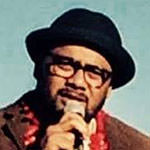
“We have a new student,” my teacher announced. “His name is ... Key-O ... Thompson from California.” It was my first day at Rankin Elementary School in Arlington, Texas, and it was a rare moment I was glad to be the only Samoan in the whole school. The way she pronounced my name, Kaio, actually changed it into a derogatory word in the Samoan language.
When my classmates gathered around during recess and asked where I was from, I felt the weight of the world on my shoulders. Texas in the 80s was not California, where other kids had at least some knowledge of Samoa. This was a defining moment where I could either elevate to cool kid, or sink to oblivion as social outcast. I wanted to fit in and feel safe; all that mattered was that other kids could identify with me.
Suddenly, I answered: “I’m from Hawaii.” I figured it was cooler to be Hawaiian than Samoan. Although Hawaii was foreign to most kids at Rankin, they had some knowledge of the island. And in some way, my Polynesian culture had been adapted as “mainstream” through the images of brown people dancing and singing cultural tunes for tourists. Explaining Samoa was just too much work.
Being as American as possible was the easiest way to survive those early years of grade school; those kids were tough if you didn’t belong. It took a while, but eventually I realized that the uniqueness of my Samoan identity was by far the coolest thing about who I was.

The Samoan Legacy; My Legacy
Like most Pacific Islanders, Samoans are here because others sought to take advantage of the economic growth America was undergoing in the mid-20th century.
My story begins over 70 years ago in American Samoa, told through the experience of my grandparents. I am proud to be a descendant of the late Rev. Timoteo and Meleane Atuatasi. After all, it was because of them that generations of Samoan people today can now call the U.S. their home.
My grandparents were the visionaries behind the hopes and dreams of Samoan people who wanted to explore the American dream. After their Naval careers (my grandfather as an enlisted sailor, my grandmother as a nurse), they became pastors and served as a sanctuary for many Samoan people, housing the many friends and family that dreamed of coming to America in the 60s and 70s. My grandparents supported those dreams both financially and spiritually. I, and others, owe them so much.
That trend of service set by my grandparents has continued for three generations in my family. My parents also became pastors/clergy, and now, my wife and I have also begun our journey in ministry. Today, I find myself asking how I can honor their legacy of sacrifice and service to others.
I think the most challenging part of maintaining the Samoan legacy is holding on to our identities amidst the more dominant ethnic groups in the U.S.
Although Pacific Islanders are often categorized as Asian Americans (initially, most had no idea what to do with us), there are clearly major cultural and geographic distinctions between the two groups.
Finding My Unique Identity
As I grew older, it became clear that my spiritual and cultural priorities differed immensely with the previous generations.
My grandparents were the first generation of Samoans who migrated to the U.S. They were pioneers of a different era, and focused on what the American way of life could offer their families. My parents were the mediators who bridged the intergenerational gap between their island-born parents and their U.S.-born children. These mediators often struggled to balance the cultural norms of their parents, and the overwhelming grip of the individualistic American culture.
What was my responsibility as a third-generation Samoan? I struggled with the notion that God’s message and purpose in the early 20th century for the diaspora of Samoan migrant communities coming to America should also apply to contemporary Samoans.
As a Samoan Christian Congregationalist, member of the clergy, and theologian in training, the language of faith and culture helped in this process of discernment of my identity as a Samoan American.
If God revealed God’s message through prophets who were chosen to address distinct circumstances of each prophet’s time, why, then, would that framework not apply to people of faith today, in context?
I asked myself similar questions pertaining to dramatic changes in the way Samoan culture functioned in the villages of the islands, and how it differed in American cities where socioeconomic factors were more burdensome. The generational divide between the experiences of migrant and American-born Samoans was also an issue.
Understanding My Responsibility
During this period of deep reflection, I read the Scripture, books, and prayed that God might help me find my voice and purpose.
I came to the realization that I was just as American as anyone else, and had to stop viewing myself as an invited guest — as my grandparents may have felt upon arrival — and accept that my Americanness was not a garment made of insignificant values and experiences. My grandparents made the same sacrifices as any Italian, Irish, or English immigrant, and they would have wanted their grandchildren to feel confident in their identity.
I realized I had a responsibility that commanded agency. This redefining of identity and purpose required new ways of thinking that simultaneously embraced and honored the legacy of those who came before like my grandparents, while also guiding my own pathway.
There’s a proverbial saying of Samoa: “O le fauna ma lona lou” (a harvesting season and its own tools for harvesting).
Ulu (breadfruit) is one of the main sources of food for Samoans — the breadfruit tree bears fruit seasonally during fuata-ulu (breadfruit season), usually from June to January. During this season, people use a lou, a very long stick, to harvest the ripe fruit. When fuata-ulu is over, the lou is thrown away; next season, a new lou is made.
This wise saying can be applied to life in general: New seasons require fresh tools of knowledge and insight appropriately applied in context to ensure that new wisdom is harvested for all future generations.
During this time of discernment and fellowship, I was serving as a youth minister to the younger generation. But it was more than that — I was also a cultural resource teaching them some of the old ways of Samoa. Most of the Samoan youth I encountered had never been to the islands or spoke the language, so they were just as excited as I was each time we met.
Since beginning the journey of ministry six years ago, my role has been to inform and educate other Samoan people that God is not confined/defined by time and space. Like Samoan culture, which is fluid and constantly changing, each generation makes its own contribution. And it is the responsibility of each generation to continue that difficult yet rewarding process of discernment.
My experience is not so different from the first-generation pioneers. Our experiences only differ in the way we are applying ourselves according to the needs of the community.
My grandparents identified what actions were necessary to address the needs of their family, and where best to fulfill those needs. I’m aware that the challenges of living out my identity as a Samoan and an American have become increasingly visible with many Samoans today opting for the latter as the more economically feasible choice. Today, Samoans must address the needs of the community based on the social, economic, and religious realities we experience as Samoan Americans.
Living Our Identities Together
Navigating the future depends heavily on how we weave these experiences together given those realities. Our history in this country has a beginning, and the primary sources of that beginning are our uncles, aunts, moms, dads, grandmas, and grandpas. It is crucial to know who we once were in order to control the narrative of who we are now. And although third-generation Samoan-Americans like myself will make our own contributions, it will remain partial if that contribution does not seek the wisdom of our forebears.
Communicating with our elders is important. The first generation has stories to tell that were not welcomed when they first arrived in America. Our experiences are their experiences, and we have a responsibility to tell their stories if they can no longer do so. There is no shortage of revisionist historians in America, which is why it matters who tells our stories. There is so much to learn through education and living interaction with each other.
In a world that is ever changing, the intergenerational gap might seem impossible to close with the rise of social media outlets and internet communication. It’s critical for people to engage each other in actual conversation and human interaction so our lived experiences can be shared amongst all generations of Asian/Pacific Islanders.
Today, it’s cool for kids to say, “I’m Samoan” — especially given the recent release of the Disney animated film “Moana”. The most amazing part of the film was that Polynesian children everywhere, whether Samoan, Hawaiian, Tongan, Guamanian, etc. could embrace their uniqueness. As a father and third generation Samoan, I was excited to see children live out their identity on screen, something I missed in my childhood.
However, although the film was culturally informative for children, it was only a portrayal. The real story is, and will continue to be, their lived experience as fourth-generation Samoan-Americans, one they will continue to tell when mine reaches its final sentence. Soifua!

Pausa Kaio (PK) Thompson is a Samoan American clergy, activist and theologian. He is an alum of the Kanana Fou Theological Seminary in American Samoa, Union Theological Seminary in the city of New York, Boston University School of Theology, and is a Ph.D. student at Claremont School of Theology. His scholarly work accentuates the theological discourse, indigenous culture and wisdom, and social justice issues of Samoa, and Samoans in diaspora. His ministry encourages people to be change agents in the world by invoking a more socially conscious ethic of Christian practice.

Maggie Chiang was born to a Taiwanese family in the City of Angels and is a full-time artist and part-time dreamer. Inspired by places both real and fictitious, her illustrations evoke a longing for adventure and the pursuit of the unknown, exploring impossible landscapes and places unseen. You can find her online at hellomaggiec.com.